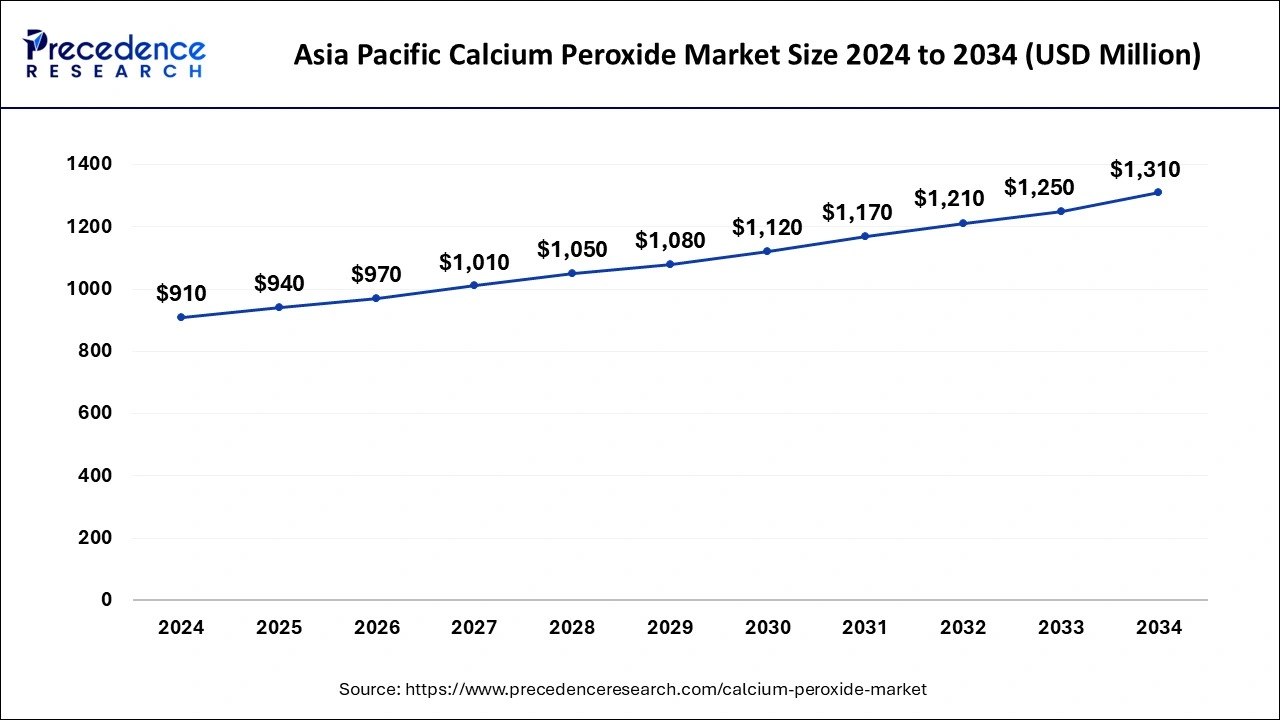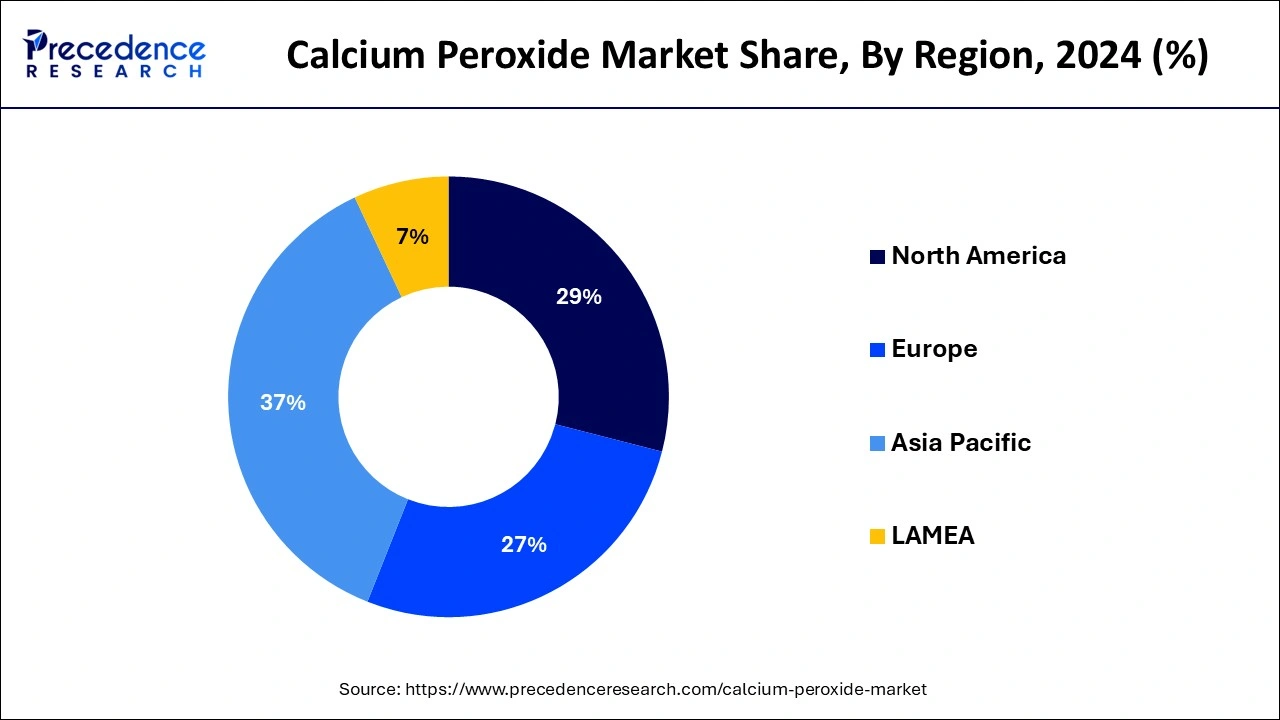December 2024
The global calcium peroxide market size is calculated at USD 2.54 billion in 2025 and is forecasted to reach around USD 3.49 billion by 2034, accelerating at a CAGR of 3.60% from 2025 to 2034. The Asia Pacific calcium peroxide market size surpassed USD 940 million in 2025 and is expanding at a CAGR of 3.71% during the forecast period. The market sizing and forecasts are revenue-based (USD Million/Billion), with 2024 as the base year.
The global calcium peroxide market size was estimated at USD 2.45 billion in 2024 and is predicted to increase from USD 2.54 billion in 2025 to approximately USD 3.49 billion by 2034, expanding at a CAGR of 3.60% from 2025 to 2034. Innovation and the market for this molecule are being driven by ongoing research and development efforts targeted at investigating new applications and enhancing the efficiency of calcium peroxide in existing applications.

The Asia Pacific calcium peroxide market size reached USD 910 million in 2024 and is predicted to be worth around USD 1,310 million by 2034, at a CAGR of 3.71% from 2025 to 2034.

Asia Pacific held the dominating share of the market in 2024. The region's calcium peroxide market has grown significantly in recent years as a result of a number of factors, including rising environmental concerns, growing agricultural operations, and an increase in food product demand. Calcium peroxide has extensive applications in agriculture as an oxygen source for soil treatment, aerobic bioremediation, and aquaculture as an oxygen generator. In addition, it serves as a bleaching agent in cheese, flour, and other culinary items. Significant players in the Asia-Pacific calcium peroxide market include China, India, Japan, and Australia. Because of its extensive agricultural activity, China, a significant agricultural hub, holds a sizable proportion of the industry.

By region, North America is observed to grow at the fastest rate in the calcium peroxide market during the forecast period. The use of calcium peroxide in a variety of sectors, including food processing, environmental remediation, and agriculture, drove the market in North America. In soil and water treatment, calcium peroxide is frequently utilized as a slow-release oxygen source to enhance soil structure and stimulate plant development. The demand for organic agricultural methods, public awareness of environmental sustainability, and strict laws governing the use of chemical pesticides and fertilizers have all had a significant impact on the market trends in North America. Key companies in the market were also forming strategic alliances and collaborations to broaden their product offerings and increase their market share.
In agriculture, calcium peroxide is frequently utilized as a slow-release oxygen source for aerobic bioremediation and as an oxygen source in soil remediation. It helps to improve the quality of the soil and encourages plant development. The industry is predicted to see a steady or even increase in demand for calcium peroxide due to the growing emphasis on environmentally friendly farming methods and sustainable agriculture practices. Because calcium peroxide can oxidize organic substances and release oxygen, it is used in wastewater treatment. It contributes to the reduction of contaminants and the enhancement of water quality. Calcium peroxide is used as a food additive in the food industry, mainly as a bleaching and flour treatment agent. It improves the baking qualities of flour and aids in its whitening.
In efforts to clean up the environment, calcium peroxide is employed, especially to treat contaminated groundwater and soil. It is useful for cleaning up locations contaminated with organic contaminants because of its capacity to release oxygen and encourage aerobic bioremediation. Growing public awareness of environmental restoration and conservation may lead to an increase in the need for calcium peroxide in this application. Developed areas with stricter environmental laws and more sophisticated farming methods might have a greater need for calcium peroxide than developing ones. Market dynamics may also be impacted by ongoing research and development initiatives meant to find new uses and boost calcium peroxide's effectiveness. Growth and competitiveness in the market may be impacted by innovations in production methods and formulations.
| Report Coverage | Details |
| Growth Rate from 2025 to 2034 | CAGR of 3.60% |
| Market Size in 2025 | USD 2.54 Billion |
| Market Size by 2034 | USD 3.49 Billion |
| Largest Market | Asia Pacific |
| Base Year | 2024 |
| Forecast Period | 2025 to 2034 |
| Segments Covered | By Grade, By Application, and By End use |
| Regions Covered | North America, Europe, Asia-Pacific, Latin America, and Middle East & Africa |
Sustainable solutions
The environmental impact of producing calcium peroxide can be greatly decreased by implementing greener manufacturing techniques that limit emissions, energy use, and waste creation. By implementing recycling programs for waste materials and byproducts produced during production, disposal costs can be decreased, and the environmental impact can be minimized. Calcium peroxide product packaging made of biodegradable materials can contribute to a decrease in plastic waste and pollution in the environment. Materials like plant-based polymers, compostable plastics, and paper-based packaging are examples of biodegradable packaging possibilities. Reduced energy consumption and carbon emissions related to the manufacture of calcium peroxide can be achieved at industrial facilities through the adoption of energy-efficient technology and practices. In the calcium peroxide market, cooperation between government agencies, research institutes, and industry players can stimulate innovation and propel the creation of long-term solutions.
Storage and handling challenges
Because calcium peroxide is so susceptible to moisture, it may break down and become less effective. To keep it stable and functioning properly, it must be stored in a dry atmosphere. Warm temperatures have the ability to hasten the breakdown of calcium peroxide, resulting in the emission of oxygen and perhaps creating safety risks. Heat degradation must be kept to a minimum by storing in a cold atmosphere. Fine dust particles that present a risk of inhalation and may aggravate respiratory tract irritation can be formed by calcium peroxide. To reduce exposure, appropriate ventilation and dust control procedures should be used during handling and processing. Regulations and recommendations may apply to the handling and storage of calcium peroxide in order to protect the environment and public health.
Environmental remediation
The process of eliminating pollution and contamination from soil, water, air, and other environmental media is known as environmental remediation. Because calcium peroxide combines with water or moisture to release oxygen, it is a chemical substance with the potential for environmental cleanup. Because calcium peroxide creates aerobic conditions that facilitate the growth of microorganisms that require oxygen, it can be used to remediate contaminated soil. Groundwater contamination locations can benefit from the use of calcium peroxide, which releases oxygen and creates aerobic conditions that help native microbes break down organic pollutants. Calcium peroxide can speed up the breakdown of organic waste and enhance treatment efficacy by providing oxygen to microbial communities.
The industrial grade segment dominated the calcium peroxide market in 2024 and is expected to continue growing rapidly during the forecast period. In the context of the calcium peroxide market, "industrial grade" usually refers to a grade or quality of calcium peroxide that is appropriate for use in industrial settings. Calcium peroxide of an industrial grade often satisfies strict purity and quality requirements required for industrial operations. Industrial-grade calcium peroxide is often formulated to assure uniformity, reliability, and efficacy in many industrial processes, including environmental remediation, wastewater treatment, soil remediation, and others. These requirements may vary depending on the intended application. The bleaching agent used in the paper and textile industries, the treatment of contaminated soil and groundwater, and numerous environmental remediation procedures are just a few of the industries that commonly use industrial-grade calcium peroxide due to its advantageous oxygen-releasing qualities.
The food grade segment holds a notable share of the calcium peroxide market. Food-grade calcium peroxide is frequently used as an ingredient in food, especially in the baking sector. It helps dough mature and enhances the texture and appearance of baked items by acting as a bleaching and dough conditioner. Furthermore, preventing the growth of germs and mold can extend the shelf life of some food goods. The food-grade section focuses on businesses that have to follow rules and guidelines regarding food safety. To guarantee that it is suitable for use in food applications, this grade of calcium peroxide is subjected to stringent testing and quality control procedures. In order to reassure customers about product safety and conformity with food industry norms, manufacturers usually offer comprehensive specifications and certificates.
The oxidizing agent segment held the largest share of the market in 2024. The market for calcium peroxide includes an important section called oxidizing agents because the compound releases oxygen gradually when it comes into contact with water. In many different industries, such as food processing, environmental cleanup, and agriculture, calcium peroxide is widely utilized as an oxidizing agent. In order to improve plant growth and soil health, it is used as an oxygen source and soil conditioner. Because of its slow-release oxygen characteristic, it is very helpful in maintaining aerobic soil conditions, which encourages plant uptake of nutrients and root development. Calcium peroxide is used in environmental applications such as soil remediation and wastewater treatment. Its oxidative qualities aid in the breakdown of organic pollutants and the cleanup of contaminated areas.
In the calcium peroxide market, the chemical intermediate segment will expand significantly during the forecast period. An inorganic substance called calcium peroxide is used as an intermediary or precursor in many different kinds of industries and chemical reactions. The main reason calcium peroxide is used in the market is because of its ability to release oxygen. When this compound comes into touch with water, it breaks down and releases oxygen. It helps to improve soil aeration and water drainage when utilized as an oxygen source in agriculture and soil remediation. Because it releases oxygen, which promotes microbial activity and aids in the degradation of organic contaminants, calcium peroxide is used in the treatment of contaminated soil and groundwater. Calcium peroxide is used in water treatment procedures to oxidize and eliminate impurities from water, such as iron, manganese, and hydrogen sulfide.
The food & beverage segment held the largest share of the calcium peroxide market in 2024. The primary application of calcium peroxide in food and beverage applications is in its capacity as a food additive. Calcium peroxide is frequently added to flour as a bleaching and dough conditioner to improve the strength of the dough and the volume and texture of baked items. In the food processing industry, it also serves as a source of oxygen, promoting the oxidation of unwanted substances and enhancing the overall quality and shelf life of food items.
Calcium peroxide is occasionally employed as a processing aid in the beverage sector, especially when treating juices and water. Because it releases oxygen and speeds up the decomposition of organic pollutants, it can aid in the removal of impurities and unwanted odors.
The agriculture segment has a considerable presence in the calcium peroxide market. When calcium peroxide comes into contact with water, it progressively releases oxygen. By encouraging aeration, which is necessary for root development and microbial activity, this oxygenation process can enhance soil structure. By encouraging microbial activity, which converts the pollutants into safe byproducts, the oxygen generated during its breakdown helps to break down these pollutants. It serves as a seed-coating agent as well. Coating seeds with calcium peroxide can increase germination rates and promote early plant growth by shielding the seeds from infections and illnesses that are carried by the soil. This can enhance overall digestion and nutrient absorption in cattle, support the growth of advantageous microbes, and maintain aerobic conditions in the digestive system.
By Grade
By Application
By End use
By Geography
For inquiries regarding discounts, bulk purchases, or customization requests, please contact us at sales@precedenceresearch.com
No cookie-cutter, only authentic analysis – take the 1st step to become a Precedence Research client
December 2024
January 2025
February 2025
October 2024